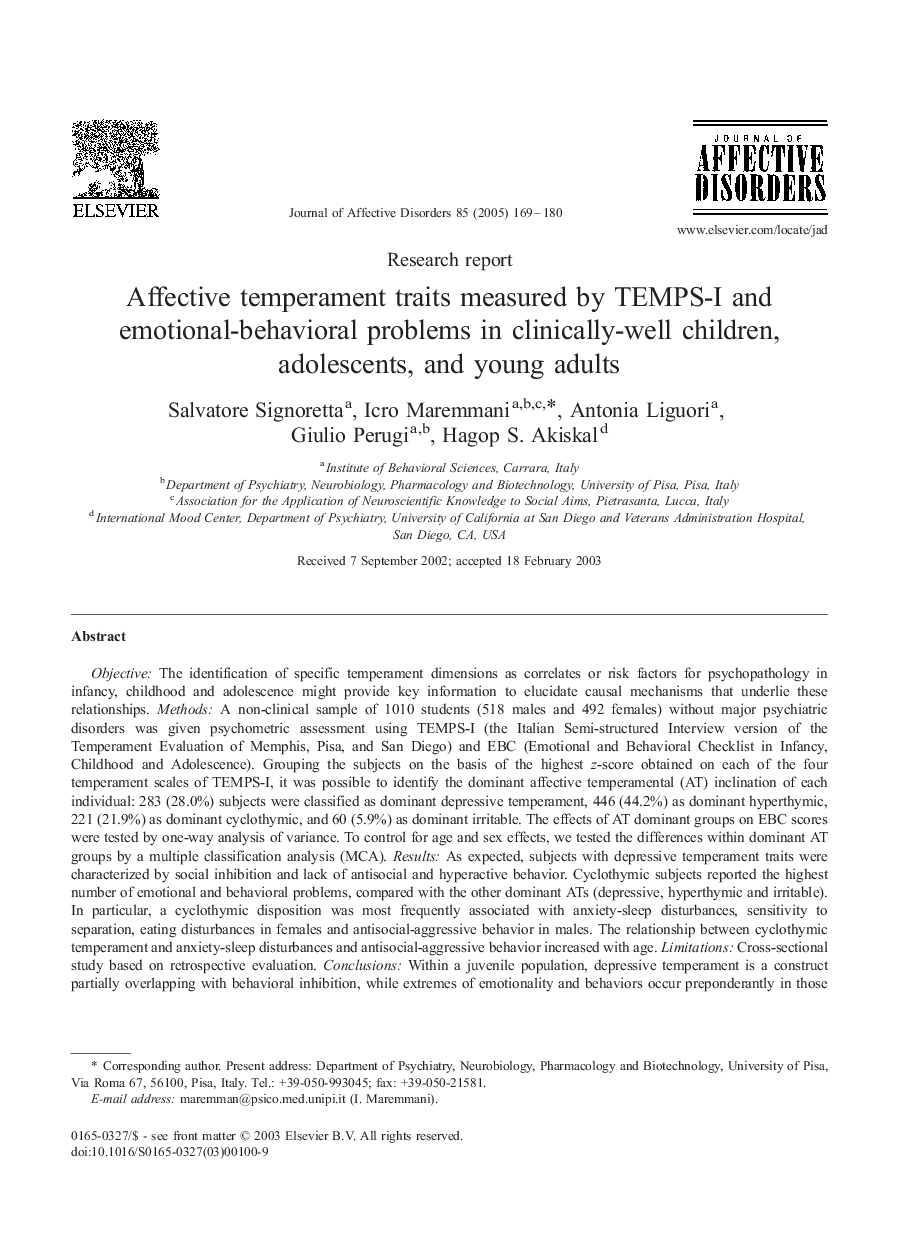| کد مقاله | کد نشریه | سال انتشار | مقاله انگلیسی | نسخه تمام متن |
|---|---|---|---|---|
| 9380731 | 1608235 | 2005 | 12 صفحه PDF | دانلود رایگان |
عنوان انگلیسی مقاله ISI
Affective temperament traits measured by TEMPS-I and emotional-behavioral problems in clinically-well children, adolescents, and young adults
دانلود مقاله + سفارش ترجمه
دانلود مقاله ISI انگلیسی
رایگان برای ایرانیان
کلمات کلیدی
موضوعات مرتبط
علوم پزشکی و سلامت
پزشکی و دندانپزشکی
روانپزشکی و بهداشت روانی
پیش نمایش صفحه اول مقاله

چکیده انگلیسی
Objective: The identification of specific temperament dimensions as correlates or risk factors for psychopathology in infancy, childhood and adolescence might provide key information to elucidate causal mechanisms that underlie these relationships. Methods. A non-clinical sample of 1010 students (518 males and 492 females) without major psychiatric disorders was given psychometric assessment using TEMPS-I (the Italian Semi-structured Interview version of the Temperament Evaluation of Memphis, Pisa, and San Diego) and EBC (Emotional and Behavioral Checklist in Infancy, Childhood and Adolescence). Grouping the subjects on the basis of the highest z-score obtained on each of the four temperament scales of TEMPS-I, it was possible to identify the dominant affective temperamental (AT) inclination of each individual: 283 (28.0%) subjects were classified as dominant depressive temperament, 446 (44.2%) as dominant hyperthymic, 221 (21.9%) as dominant cyclothymic, and 60 (5.9%) as dominant irritable. The effects of AT dominant groups on EBC scores were tested by one-way analysis of variance. To control for age and sex effects, we tested the differences within dominant AT groups by a multiple classification analysis (MCA). Results: As expected, subjects with depressive temperament traits were characterized by social inhibition and lack of antisocial and hyperactive behavior. Cyclothymic subjects reported the highest number of emotional and behavioral problems, compared with the other dominant ATs (depressive, hyperthymic and irritable). In particular, a cyclothymic disposition was most frequently associated with anxiety-sleep disturbances, sensitivity to separation, eating disturbances in females and antisocial-aggressive behavior in males. The relationship between cyclothymic temperament and anxiety-sleep disturbances and antisocial-aggressive behavior increased with age. Limitations: Cross-sectional study based on retrospective evaluation. Conclusions: Within a juvenile population, depressive temperament is a construct partially overlapping with behavioral inhibition, while extremes of emotionality and behaviors occur preponderantly in those with cyclothymic traits. The cyclothymic disposition turned out to be the most 'morbid', and associated with both internalizing and externalizing disturbances.
ناشر
Database: Elsevier - ScienceDirect (ساینس دایرکت)
Journal: Journal of Affective Disorders - Volume 85, Issues 1â2, March 2005, Pages 169-180
Journal: Journal of Affective Disorders - Volume 85, Issues 1â2, March 2005, Pages 169-180
نویسندگان
Salvatore Signoretta, Icro Maremmani, Antonia Liguori, Giulio Perugi, Hagop S. Akiskal,